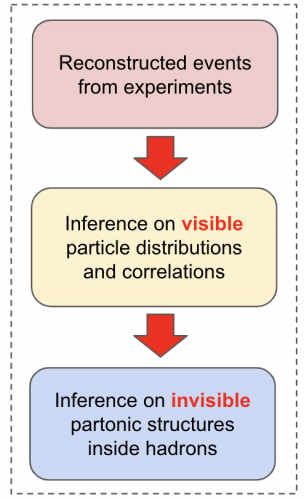One of the grand challenges of the program to image the nucleon's internal 3-dimensional quark and gluon structure is our ability to transform the observed data, presented as a collection of momentum 4-vectors of the final state particles (collectively called events) in high-energy particle collisions, into suitable representations that can be interpreted using theoretical tools in QCD. In general such endeavor involves two stages of analysis:
Inference on visible particle momentum distributions: also known as differential cross sections, the objective is to map out the underlying probability distributions that characterize the momentum distributions of final state particles as a product of a high-energetic collision between two particles. In practice, detector systems induce distortions, such as smearing effects, detector efficiencies, and electromagnetic radiative effects, that prevent direct access to the true underlying distributions, which constitute an inverse problem. The Theory Center is actively working on implementing AI/ML strategies that can accurately make inferences on the underlying distributions without the need to utilize theory biases that are commonly used in standard approaches. In particular, generative models such as GANs offer the possibility to train the models directly at the event level, avoiding the need to infer the underlying probability distributions using the traditional histograming approach. As such, generative models in ML provide a new flexible and unbiased form of data representation for the observed collection of events that allows us to explore in detail particle correlations that emerge from the underlying quark and gluon degrees of freedom.

The scientific mission.
Inference on invisible quark and gluon quantum correlation functions (QCFs) in nucleons and nuclei: in the framework of QCD factorization, the differential cross sections can be expressed as convolutions of QCFs (PDFs, TMDs, GPDs) with process-dependent and calculable coefficient functions. Since QCFs cannot be solved in a closed form in terms of cross sections, it constitutes an inverse problem. With the aid of ML, the Theory Center engages in research activities that tackle the inverse problem using the Bayesian approach to solving the inverse problem.

